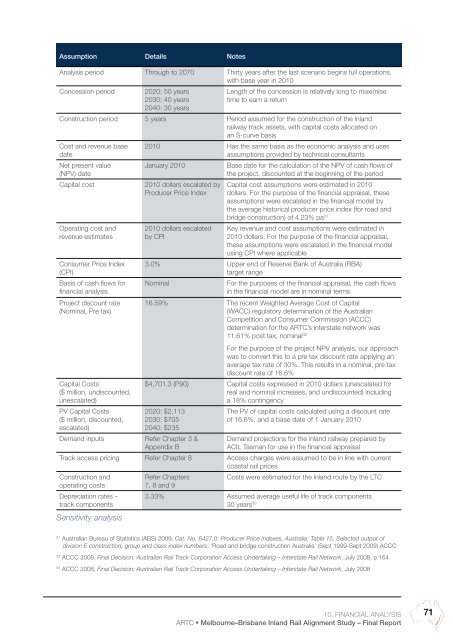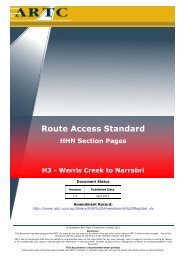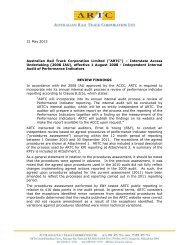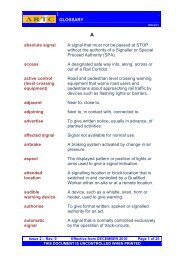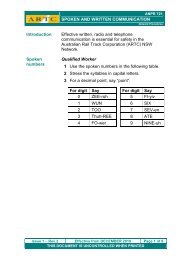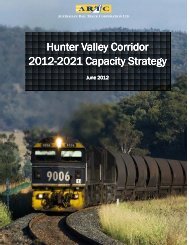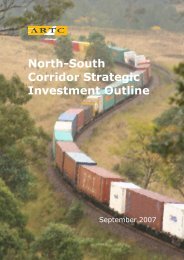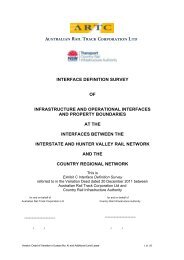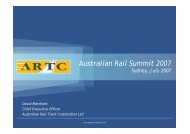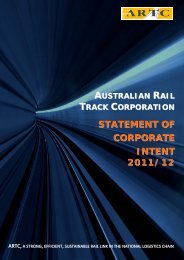MelbourneâBrisbane Inland Rail Alignment Study - Australian Rail ...
MelbourneâBrisbane Inland Rail Alignment Study - Australian Rail ...
MelbourneâBrisbane Inland Rail Alignment Study - Australian Rail ...
Create successful ePaper yourself
Turn your PDF publications into a flip-book with our unique Google optimized e-Paper software.
Assumption Details Notes<br />
Analysis period Through to 2070 Thirty years after the last scenario begins full operations,<br />
with base year in 2010<br />
Concession period<br />
2020: 50 years<br />
2030: 40 years<br />
2040: 30 years<br />
Length of the concession is relatively long to maximise<br />
time to earn a return<br />
Construction period 5 years Period assumed for the construction of the inland<br />
railway track assets, with capital costs allocated on<br />
an S-curve basis<br />
Cost and revenue base<br />
date<br />
Net present value<br />
(NPV) date<br />
Capital cost<br />
Operating cost and<br />
revenue estimates<br />
Consumer Price Index<br />
(CPI)<br />
Basis of cash flows for<br />
financial analysis<br />
Project discount rate<br />
(Nominal, Pre tax)<br />
Capital Costs<br />
($ million, undiscounted,<br />
unescalated)<br />
PV Capital Costs<br />
($ million, discounted,<br />
escalated)<br />
Demand inputs<br />
2010 Has the same basis as the economic analysis and uses<br />
assumptions provided by technical consultants<br />
January 2010<br />
Base date for the calculation of the NPV of cash flows of<br />
the project, discounted at the beginning of the period<br />
2010 dollars escalated by<br />
Producer Price Index<br />
2010 dollars escalated<br />
by CPI<br />
Capital cost assumptions were estimated in 2010<br />
dollars. For the purpose of the financial appraisal, these<br />
assumptions were escalated in the financial model by<br />
the average historical producer price index (for road and<br />
bridge construction) of 4.23% pa 31<br />
Key revenue and cost assumptions were estimated in<br />
2010 dollars. For the purpose of the financial appraisal,<br />
these assumptions were escalated in the financial model<br />
using CPI where applicable<br />
3.0% Upper end of Reserve Bank of Australia (RBA)<br />
target range<br />
Nominal<br />
For the purposes of the financial appraisal, the cash flows<br />
in the financial model are in nominal terms<br />
16.59% The recent Weighted Average Cost of Capital<br />
(WACC) regulatory determination of the <strong>Australian</strong><br />
Competition and Consumer Commission (ACCC)<br />
determination for the ARTC’s interstate network was<br />
11.61% post tax, nominal 32<br />
For the purpose of the project NPV analysis, our approach<br />
was to convert this to a pre tax discount rate applying an<br />
average tax rate of 30%. This results in a nominal, pre tax<br />
discount rate of 16.6%<br />
$4,701.3 (P90) Capital costs expressed in 2010 dollars (unescalated for<br />
real and nominal increases, and undiscounted) including<br />
a 18% contingency<br />
2020: $2,113<br />
2030: $705<br />
2040: $235<br />
Refer Chapter 3 &<br />
Appendix B<br />
The PV of capital costs calculated using a discount rate<br />
of 16.6%, and a base date of 1 January 2010<br />
Demand projections for the inland railway prepared by<br />
ACIL Tasman for use in the financial appraisal<br />
Track access pricing Refer Chapter 8 Access charges were assumed to be in line with current<br />
coastal rail prices<br />
Construction and<br />
operating costs<br />
Depreciation rates –<br />
track components<br />
Sensitivity analysis<br />
Refer Chapters<br />
Costs were estimated for the inland route by the LTC<br />
7, 8 and 9<br />
3.33% Assumed average useful life of track components<br />
30 years 33<br />
31<br />
<strong>Australian</strong> Bureau of Statistics (ABS) 2009, Cat. No. 6427.0: Producer Price Indexes, Australia: Table 15. Selected output of<br />
division E construction, group and class index numbers, ‘Road and bridge construction Australia’ (Sept 1999-Sept 2009) ACCC<br />
32<br />
ACCC 2008, Final Decision: <strong>Australian</strong> <strong>Rail</strong> Track Corporation Access Undertaking – Interstate <strong>Rail</strong> Network, July 2008, p 164<br />
33<br />
ACCC 2008, Final Decision: <strong>Australian</strong> <strong>Rail</strong> Track Corporation Access Undertaking – Interstate <strong>Rail</strong> Network, July 2008<br />
10. Financial analysis<br />
ARTC • Melbourne–Brisbane <strong>Inland</strong> <strong>Rail</strong> <strong>Alignment</strong> <strong>Study</strong> – Final Report<br />
71


